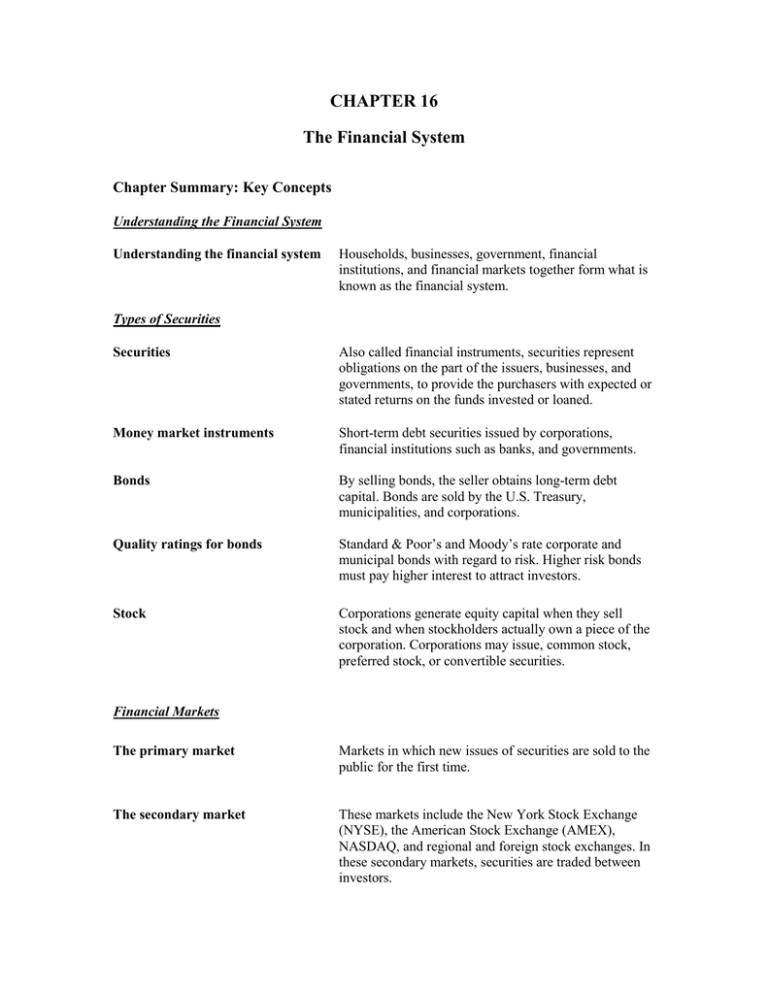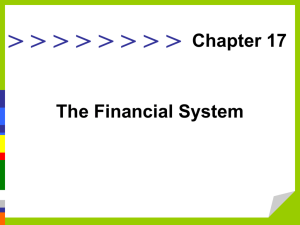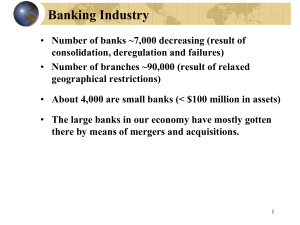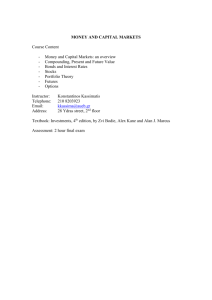Ch 16 - Wiley
advertisement

CHAPTER 16 The Financial System Chapter Summary: Key Concepts Understanding the Financial System Understanding the financial system Households, businesses, government, financial institutions, and financial markets together form what is known as the financial system. Types of Securities Securities Also called financial instruments, securities represent obligations on the part of the issuers, businesses, and governments, to provide the purchasers with expected or stated returns on the funds invested or loaned. Money market instruments Short-term debt securities issued by corporations, financial institutions such as banks, and governments. Bonds By selling bonds, the seller obtains long-term debt capital. Bonds are sold by the U.S. Treasury, municipalities, and corporations. Quality ratings for bonds Standard & Poor’s and Moody’s rate corporate and municipal bonds with regard to risk. Higher risk bonds must pay higher interest to attract investors. Stock Corporations generate equity capital when they sell stock and when stockholders actually own a piece of the corporation. Corporations may issue, common stock, preferred stock, or convertible securities. Financial Markets The primary market Markets in which new issues of securities are sold to the public for the first time. The secondary market These markets include the New York Stock Exchange (NYSE), the American Stock Exchange (AMEX), NASDAQ, and regional and foreign stock exchanges. In these secondary markets, securities are traded between investors. 16-2 Part VI Managing Financial Resources Understanding Stock Markets The New York Stock Exchange The NYSE or “Big Board” is the largest secondary market in the world. It is where most of the largest, bestknown U.S. companies’ stocks are traded. Trading involves face-to-face bidding between seated traders at posts on the exchange floor. The NASDAQ stock market Also known as the National Association of Securities Dealers Automated Quotation system, it is a computerized communications network where buy and sell orders are executed electronically. Other U.S. stock markets AMEX and several regional exchanges trade in the stocks of smaller firms. Foreign stock markets All developed countries, and many developing countries, have stock exchanges. ECNs and the future of stock markets Investor participation in the stock markets Electronic communications networks, sometimes called the fourth market, is where buyers and sellers meet in a virtual stock market and trade directly with one another. Investors need to use the services of a brokerage firm to buy or sell stocks. Investors establish an account with the brokerage firm and then enter orders to trade stocks. Financial Institutions Financial institutions Intermediary between savers and borrowers, collecting funds from savers and then lending the funds to individuals, businesses, and governments. Financial institutions greatly increase the efficiency and effectiveness of the transfer of funds from savers to users. Commercial banks Largest and probably the most important financial institutions in the United States and in most other countries. Services include a wide range of checking and savings deposit accounts, consumer loans, credit cards, home mortgage loans, business loans, and trust services. Savings banks and credit unions Savings banks offer many of the same services as commercial banks, including checking accounts, but they are not major lenders to businesses. Credit unions are cooperative financial institutions that are owned by their depositors, all of whom are members. Nondepository financial Chapter 16 The Financial System 16-3 institutions Nondepository financial institutions accept funds from businesses and households, much of which they then invest. Generally, these institutions do not offer checking accounts. Mutual funds Financial intermediaries that raise money from investors by selling shares. They then use the money to invest in securities that are consistent with the mutual fund’s objectives. The Federal Reserve System Organization of the Fed The Federal Reserve System (The Fed) is a network of 12 regional banks controlled by a board of governors who each serve 14-year terms. The Federal Open Markets Committee (FOMC) of the Fed is responsible for setting most policies concerning monetary policy and interest rates. Check clearing and the Fed The Fed centralizes the process by which funds are transferred from the check writer to the recipient. Monetary policy The Fed’s most important function is controlling the money supply and credit. Using tools such as reserve requirements, the discount rate, federal funds rate targets, and open market operations, the Fed promotes economic growth and a stable dollar through monetary policy. Regulation of the Financial System Bank regulation Government regulation of the financial markets Banks are among the nation’s most heavily regulated businesses. The main purpose of bank regulation is to ensure public confidence in the safety and security of the banking system. All banks have either state or federal charters. Regulation of U.S. financial markets is primarily a function of the federal government, although states also regulate them. U.S. Securities and Exchange Commission (SEC), created in 1934, is the principal federal regulatory overseer of the securities markets. The SEC’s mission is to administer securities laws and protect investors in public securities transactions. Insider trading The use of material nonpublic information about a company to make investment profits. Industry self-regulation Two examples of self-regulation are the rules of conduct established by the various professional organizations and 16-4 Part VI Managing Financial Resources market surveillance techniques used by the major securities markets. The Financial System: A Global Perspective Global perspective Virtually all nations have some sort of a central bank, similar to the U.S. Federal Reserve. Examples include the Banks of Canada, England, Japan and the European Central Bank. These central banks play roles much like that of the Fed, such as controlling the money supply and regulating banks. Business Vocabulary call provision common stock convertible securities debenture Federal Deposit Insurance Corporation (FDIC) Federal Open Markets Committee (FOMC) Federal Reserve System (Fed) financial institution financial market financial system government bonds initial public offering (IPO) insider trading investment-grade bond limit order market order money market instruments municipal bonds mutual fund open market operations primary market secondary market securities speculative (junk) bond subprime mortgage Application of Vocabulary Select the term from the list above that best completes the statements below. Write that term in the space provided. 1. The ______________________________________________ sets most policies concerning monetary policy and interest rates. 2. ___________________________________ are markets in which securities are issued and traded. 3. ________________________________ are short-term debt securities issued by governments, financial institutions, and corporations. Chapter 16 The Financial System 16-5 4. When a company offers stock for sale to the general public for the first time it is known as _____________________________. 5. .___________________________ are bonds with ratings of BBB and above. 6. The _______________________________ is the central bank of the United States 7. ______________________ gives the bondholder or preferred stockholder the right to exchange the bond or preferred stock for a fixed number of shares of common stock. 8. 9. U.S. Department of the Treasury sells these types of bonds: _______________________. 10. ________________________________ is the basic form of corporate ownership. 11. The federal agency that insures deposits at commercial and savings banks is called the _________________________________. 12. Financial intermediaries that raise money from investors by selling shares are called ______________________. 13. A ____________________ instructs the broker to obtain the best possible price, the highest price when selling, and the lowest price when buying. 14. System process by which money flows from savers to users is called the _________________. 15. The collection of financial markets in which previously issued securities are traded among investors is called ______________________. 16. _________________________ are financial instruments that represent obligations on the part of the issuers to provide the purchasers with expected stated returns on the funds invested or loaned. 17. The market in which shares of stock are bought and sold by investors is called the __________________________. 18. A ______________________________ is an uninsured bond. 19. The technique of controlling the money supply growth rate by buying or selling U.S. Treasury securities is called _______________________. 20. The ____________________________ is the intermediary between savers and borrowers, collecting funds from savers and then lending the funds to individuals, businesses, and governments. 21. Loans made to borrowers with poor credit ratings are called _____________________. 22. The use of material nonpublic information about a company to make investment profits is called ___________________________. 16-6 Part VI Managing Financial Resources 23. A __________________________allows the issuer to redeem the bond before its maturity at a specified price. 24. ___________________________ are bonds issued by state or local governments. 25. _______________________________ are the financial market in which firms and governments issue securities and sell them initially to the general public. Analysis of Learning Objectives Learning Objective 16.1: Outline the importance and structure of the financial system. True of False 1. ____ Users expect to earn a rate of return in exchange for the use of their funds. 2. ____ The financial system is the process by which funds are transferred between those having excess funds (savers) and those needing additional funds (users). 3. ____ Although direct transfers are possible, most funds flow from users to savers. 4. ____ Financial markets, financial institutions, and financial instruments (securities) make up the financial system. 5. ____ Commercial banks are financial institutions. 6. ____ A well-functioning financial system is critical to the overall health of a nation’s economy. 7. ____ Businesses and governments are net users. 8. ____ Generally, individuals are net users. Learning Objective 16.2: List the various types of securities. Multiple Choice 1. The true owners of a corporation: a. are the common shareholders. b. have voting rights. 2. c. have a residual claim to assets. d. all of the above. Preferred stockholders: a. are contributors of debt, not equity capital. b. usually have a vote. Chapter 16 The Financial System 16-7 c. have a prior claim to assets. d. all of the above. 3. In the event of a firm’s dissolution, the first claim on its assets belongs to: a. common stockholders. b. preferred stockholders. c. bondholders. d. all investors have an equal claim to assets. 4. A person who prefers being a creditor to being an owner would invest in: a. bonds. b. preferred stock. 5. c. common stock. d. an IPO. Short-term debt securities sold by corporations and governments are: a. bonds. b. common stocks. c. preferred securities. d. money market instruments. Learning Objective 16.3: Define financial markets and distinguish between the primary and secondary financial markets. Multiple Choice 1. The initial issue of stock or bonds takes place in the: a. American Stock Exchange. c. secondary market. b. primary market. d. all of the above. 2. When investors trade securities among themselves they do so by means of the: a. Dow Jones Industrial Index. c. primary market. b. Standard & Poor’s rating services. d. secondary market. 3. Each time securities are traded on the secondary market, the issuing corporation receives: a. 100 % of the selling price. c. 25% of the selling price. b. 50% of the selling price. d. none of the selling price. 4. Rather than going directly to the public with a new issue of stock, most corporations use: a. the New York Stock Exchange. c. investment bankers. b. the American Stock Exchange. d. the secondary market. Learning Objective 16.4: Discuss the characteristics of the major stock exchanges. Multiple Choice 1. This exchange focuses on stocks of small firms. 16-8 Part VI Managing Financial Resources a. NYSE. b. NASDAQ. 2. This exchange is actually a computerized communications network that links member investment firms. a. NYSE. b. NASDAQ. 3. c. American Stock Exchange d. London Exchange The largest exchange in the world is: a. NYSE b. NASDAQ 5. c. American Stock Exchange. d. London Exchange. Which exchange is considered the most international? a. NYSE b. NASDAQ 4. c. American Stock Exchange. d. London Exchange. c. American Stock Exchange d. London Exchange The oldest exchange is: a. NYSE b. NASDAQ c. American Stock Exchange d. London Exchange Learning Objective 16.5: Discuss the organization and functioning of financial institutions. Multiple Choice 1. A form of cooperative that acts as a depository and grants loans to its members is a(n): a. commercial bank. c. commercial finance company. b. credit union. d. consumer finance company. 2. A profit-making business that holds deposits for individuals and business firms and makes loans to individuals and business firms is a: a. commercial bank. c. insurance company. b. commercial finance company. d. credit union. 3. An institution that offers both saving and checking accounts and that has historically been the major source of home loans is called a: a. consumer finance company. c. savings bank. b. commercial bank. d. credit union. 4. All of the following are deposit institutions, EXCEPT: a. pension funds. c. commercial banks. b. credit unions. d. savings banks. c. savings and loan associations 5. These types of institutions provide financial protection for their policyholders, make commercial and real estate mortgage loans, and purchase government bonds: a. mutual savings banks. d. credit unions. Chapter 16 The Financial System 16-9 b. insurance companies. c. commercial banks. 6. e. consumer finance companies. What type of financial institution offers short-term loans to businesses but not to individuals? a. credit unions d. commercial banks b. consumer finance companies e. commercial finance companies Learning Objective 16.6: Explain the functions of the Federal Reserve System and the tools it uses to control the money supply and credit. True or False 1._____ An increase in the reserve requirement or the discount rate will increase the money supply. 2._____ The most essential function of the Federal Reserve System is to control the supply of money and credit in order to promote economic growth and a stable dollar. 3._____ The Fed is the U.S. Central Bank. 4._____ The Federal Reserve System has no control over interest rates. 5._____ If the Fed buys government bonds on the open market, the money supply will increase. 6._____ The Fed is designed to be politically dependent on the current administration and the Congressional appropriations process. Learning Objective 16.7: Evaluate the major features of regulations and laws affecting the financial system. Fill in the blank 1. 3. 4. If a company’s officers, directors, lawyers, accountants, investment bankers, or even outside friends or reporters use material, nonpublic information about a company to make investment profits, they are engaged in _________________.2. The federal agency that regulates the securities markets is the__________________. 5. Before a new security can be issued, the issuer must prepare and submit a __________________. 6. The SEC tries to ensure__________________________, that is, investors should have access to all relevant information so they can make informed investment decisions. 16-10 Part VI Managing Financial Resources Learning Objective 16.8: Describe the global financial system. True or False 1._____ American banks make up the majority of the global financial giants. 2._____ Virtually all nations have a central bank. 3._____ Foreign currencies and securities held by the Fed are counted as part of the U.S. banking system’s reserves. 4._____ Transactions in international markets have no impact on the domestic money supply. Self Review True or False 1._____ Financial control is the process that periodically checks actual revenues, costs, and expenses against a firm’s forecasts and plans. 2._____ Commercial paper is another name for long-term debt. 3._____ Having too much cash on hand can be costly. 4._____ Not having enough cash on hand can be costly. 5._____ The amount and timing of borrowing are important aspects of the financial plan. 6._____ Leverage is a technique of increasing the return on investment. 7._____ If the Federal Reserve Bank buys government bonds on the open market, the money supply with decline. 8._____ Commercial banks and savings banks both focus on business banking. 9._____ A demand deposit is another name for a checking account. 10._____ Commercial finance companies usually make long-term loans to businesses. 11._____ All national banks must belong to the Federal Reserve System. 12._____ If the Federal Reserve Bank increases the reserve requirements, member banks will have less funds available to make loans. Chapter 16 The Financial System 16-11 13._____ With a debit card, consumers’ purchases are deducted directly from their accounts. 14._____ In a secured loan, borrowers need not pledge collateral. 15._____ Loans repaid over one year or longer, bonds, and equity funds are all considered long-term sources of funds. 16._____ Commercial paper is more risky than T-Bills; thus it pays a higher rate of interest. 17._____ Banks examiners are trained representatives who inspect the financial records and management practices of financial institutions. 18._____ Equity capital is obtained through the sale of bonds. 19._____ Insurance companies are depository institutions. Multiple Choice 1. Which of the following has no maturity date? a. equity b. debt 2. The largest and most common financial institutions in the United States are: a. commercial banks. b. consumer finance companies. 3. c. time deposits. d. deposit accounts. The clearinghouse for checks is the: a. Internet Banking System. b. Federal Reserve System. c. Bank of America. 5. c. savings banks. d. commercial finance companies. Accounts similar to checking accounts that are offered by credit unions are called: a. share draft accounts. b. now accounts. 4. c. both equity and debt mature d. neither has a maturity date d. Federal Check Regulatory Commission. e. Internal Revenue Service. Which of the following is NOT true of commercial paper? a. It is issued by major corporations to raise money. b. It is a short-term promissory note. c. It is a secured short-term loan.d. It is backed by the reputation of the issuing company. e. All of the above are true. 6. Corporate bonds are a form of: 16-12 Part VI Managing Financial Resources a. commercial paper. b. short-term debt financing. c. long-term equity financing. 7. Banks: a. b. c. d. e. 8. d. short-term equity financing. e. long-term debt financing. raise money by accepting deposits. pool deposits and use them to make loans to consumers and businesses. make money by charging a higher rate on loans than they pay on deposits. make money on fees they charge to customers for services performed. all of the above. Junk bonds: a. generally earn lower interest rates than AAA-rated bonds. b. offer higher yields in return for taking greater risks. c. are already in default. d. all of the above. 9. Sales charges levied on mutual funds are commonly called: a. commissions. b. loads. c. DRIPs. d. P/E ratios. Application Exercises 1. Alice Brown is a recent widow who received $100,000 from her husband’s life insurance policy. She plans to use the money as a down payment for a new home in about a year and wants to put the money in a safe place until then. Her inclination is to put it in the bank, but she has also heard that sometimes banks fail. What can you tell her about the safety of her proposed deposit? What should she look for when selecting a bank? An investment vehicle? Chapter 16 The Financial System 16-13 Short Essay Questions 1. What are securities? What are the risks and rewards of investing in securities? What steps can an individual investor take to minimize risk? 2. What are primary markets? How do they differ from secondary markets? 16-14 Part VI Managing Financial Resources 3. What is the Federal Reserve System and What role does it play in modern finance? Name and discuss the major tools the Federal Reserve System has at its disposal.






